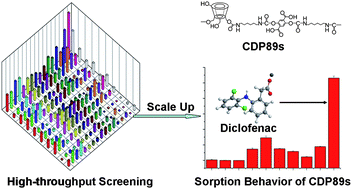Design and high-throughput synthesis of cyclodextrin-based polyurethanes with enhanced molecular recognition properties†
Abstract
51 highly cross-linked cyclodextrin-based polyurethanes were produced using a high-throughput synthesis method. The reaction was carried out in a multiwell plate using three different cyclodextrins, namely α-, β- and γ-cyclodextrin, four different diisocyanate crosslinkers (1,4-phenylene diisocyanate, toluene 2,4-diisocyanate, isophorone diisocyanate, and hexamethylene diisocyanate), and four different carboxyl-containing dihydroxy monomers (2,2-bis(hydroxymethyl)propionic acid, 2,5-dihydroxybenzoic acid, 2,5-dihydroxyterephthalic acid, and 1,4-dihydroxy-2-naphthoic acid). The interactions of the produced polyurethanes with a mixture of molecules of interest, namely acetaminophenol, atenolol, caffeine, ofloxacin, ciprofloxacin, tetracycline, sulfamethoxazole, chloramphenicol, (±)-propranolol and diclofenac, were studied in water. It was demonstrated that the binding properties of the produced polyurethanes could be tuned by selecting the monomers and crosslinkers used for their synthesis. In addition to the hydrophobic inclusion of the target into the cyclodextrin macrocycle, a set of synergistic interactions were shown to influence the sorption behavior of the produced polyurethanes. Two selected formulations were upscaled at the gram quantity; the binding results showed a similar behavior as that of the polyurethanes produced using the high-throughput method, thus demonstrating the suitability of the method to produce polymers with enhanced molecular recognition properties.


 Please wait while we load your content...
Please wait while we load your content...